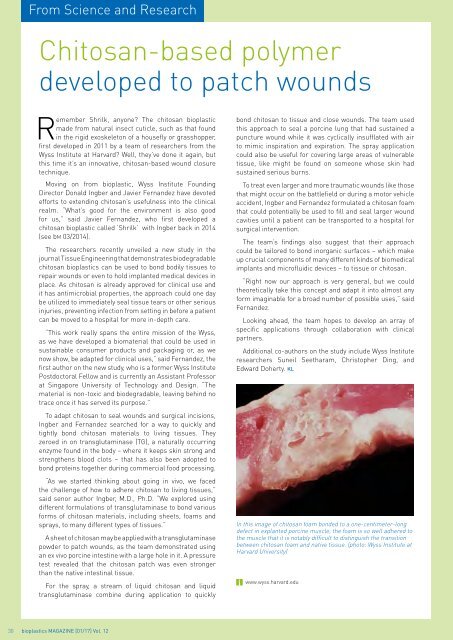Issue 01/2017
bioplasticsMAGAZINE_1701
bioplasticsMAGAZINE_1701
You also want an ePaper? Increase the reach of your titles
YUMPU automatically turns print PDFs into web optimized ePapers that Google loves.
From Materials Science and Research<br />
Chitosan-based polymer<br />
developed to patch wounds<br />
Remember Shrilk, anyone? The chitosan bioplastic<br />
made from natural insect cuticle, such as that found<br />
in the rigid exoskeleton of a housefly or grasshopper,<br />
first developed in 2<strong>01</strong>1 by a team of researchers from the<br />
Wyss Institute at Harvard? Well, they’ve done it again, but<br />
this time it’s an innovative, chitosan-based wound closure<br />
technique.<br />
Moving on from bioplastic, Wyss Institute Founding<br />
Director Donald Ingber and Javier Fernandez have devoted<br />
efforts to extending chitosan’s usefulness into the clinical<br />
realm. “What’s good for the environment is also good<br />
for us,” said Javier Fernandez, who first developed a<br />
chitosan bioplastic called ‘Shrilk’ with Ingber back in 2<strong>01</strong>4<br />
(see bM 03/2<strong>01</strong>4).<br />
The researchers recently unveiled a new study in the<br />
journal Tissue Engineering that demonstrates biodegradable<br />
chitosan bioplastics can be used to bond bodily tissues to<br />
repair wounds or even to hold implanted medical devices in<br />
place. As chitosan is already approved for clinical use and<br />
it has antimicrobial properties, the approach could one day<br />
be utilized to immediately seal tissue tears or other serious<br />
injuries, preventing infection from setting in before a patient<br />
can be moved to a hospital for more in-depth care.<br />
“This work really spans the entire mission of the Wyss,<br />
as we have developed a biomaterial that could be used in<br />
sustainable consumer products and packaging or, as we<br />
now show, be adapted for clinical uses,” said Fernandez, the<br />
first author on the new study, who is a former Wyss Institute<br />
Postdoctoral Fellow and is currently an Assistant Professor<br />
at Singapore University of Technology and Design. “The<br />
material is non-toxic and biodegradable, leaving behind no<br />
trace once it has served its purpose.”<br />
To adapt chitosan to seal wounds and surgical incisions,<br />
Ingber and Fernandez searched for a way to quickly and<br />
tightly bond chitosan materials to living tissues. They<br />
zeroed in on transglutaminase (TG), a naturally occurring<br />
enzyme found in the body – where it keeps skin strong and<br />
strengthens blood clots – that has also been adopted to<br />
bond proteins together during commercial food processing.<br />
“As we started thinking about going in vivo, we faced<br />
the challenge of how to adhere chitosan to living tissues,”<br />
said senor author Ingber, M.D., Ph.D. “We explored using<br />
different formulations of transglutaminase to bond various<br />
forms of chitosan materials, including sheets, foams and<br />
sprays, to many different types of tissues.”<br />
A sheet of chitosan may be applied with a transglutaminase<br />
powder to patch wounds, as the team demonstrated using<br />
an ex vivo porcine intestine with a large hole in it. A pressure<br />
test revealed that the chitosan patch was even stronger<br />
than the native intestinal tissue.<br />
For the spray, a stream of liquid chitosan and liquid<br />
transglutaminase combine during application to quickly<br />
bond chitosan to tissue and close wounds. The team used<br />
this approach to seal a porcine lung that had sustained a<br />
puncture wound while it was cyclically insufflated with air<br />
to mimic inspiration and expiration. The spray application<br />
could also be useful for covering large areas of vulnerable<br />
tissue, like might be found on someone whose skin had<br />
sustained serious burns.<br />
To treat even larger and more traumatic wounds like those<br />
that might occur on the battlefield or during a motor vehicle<br />
accident, Ingber and Fernandez formulated a chitosan foam<br />
that could potentially be used to fill and seal larger wound<br />
cavities until a patient can be transported to a hospital for<br />
surgical intervention.<br />
The team’s findings also suggest that their approach<br />
could be tailored to bond inorganic surfaces – which make<br />
up crucial components of many different kinds of biomedical<br />
implants and microfluidic devices – to tissue or chitosan.<br />
“Right now our approach is very general, but we could<br />
theoretically take this concept and adapt it into almost any<br />
form imaginable for a broad number of possible uses,” said<br />
Fernandez.<br />
Looking ahead, the team hopes to develop an array of<br />
specific applications through collaboration with clinical<br />
partners.<br />
Additional co-authors on the study include Wyss Institute<br />
researchers Suneil Seetharam, Christopher Ding, and<br />
Edward Doherty. KL<br />
In this image of chitosan foam bonded to a one-centimeter-long<br />
defect in explanted porcine muscle, the foam is so well adhered to<br />
the muscle that it is notably difficult to distinguish the transition<br />
between chitosan foam and native tissue. (photo: Wyss Institute at<br />
Harvard University)<br />
www.wyss.harvard.edu<br />
30 bioplastics MAGAZINE [<strong>01</strong>/17] Vol. 12


















